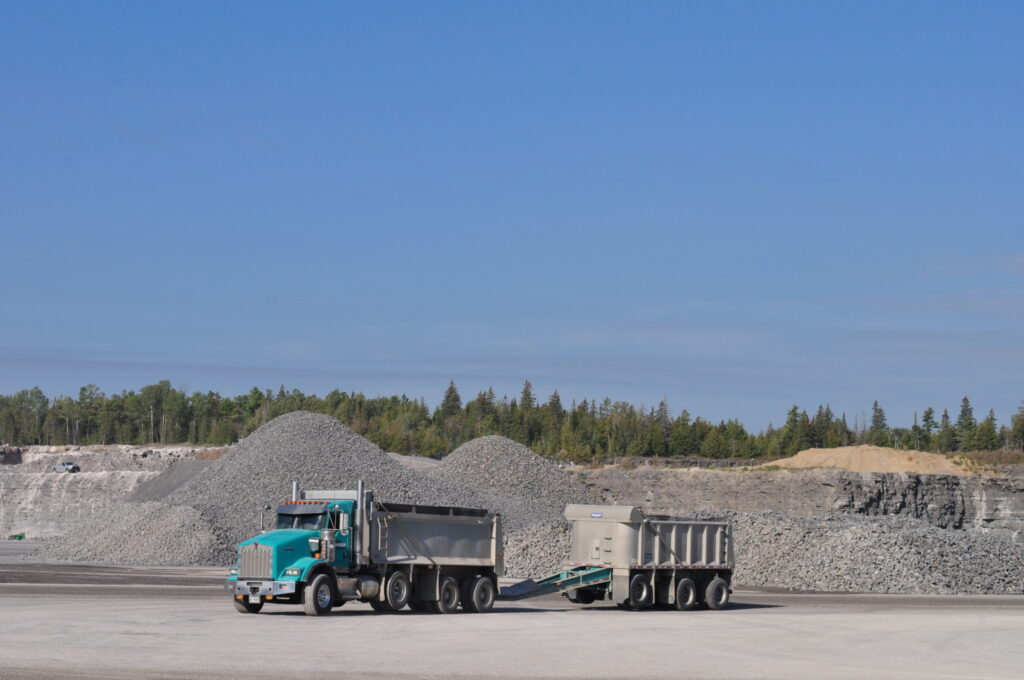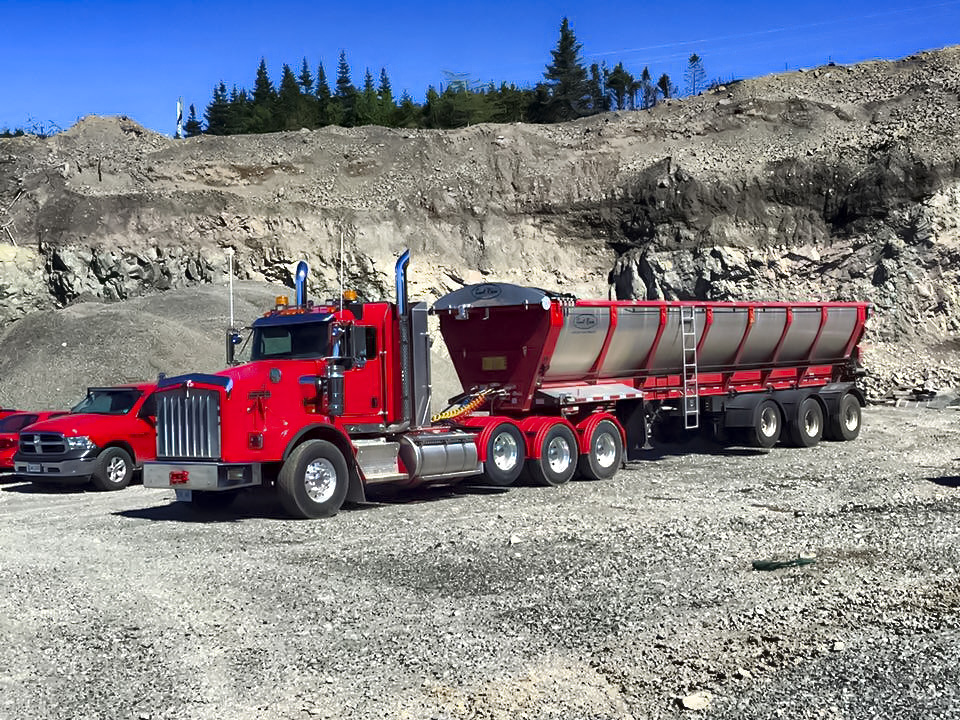Versatility, efficiency key when choosing aggregate trailers
During the Covid-19 pandemic, the trucking industry enjoyed a rare moment in the sun, lauded for keeping the economy moving and supplying vital goods such as food and medicine. But little thought was given to those hauling aggregate from gravel pits and quarries to construction sites – an equally important role in keeping Canada’s economy functioning.
Don’t underestimate the importance of aggregate – sand, gravel and stone — and those who transport it.
If you’re reading this at home, about 250 tonnes of aggregate – or 12 truckloads – went into building that house, according to the Ontario Stone, Sand and Gravel Association. If you’re reading it in a tall office building, then about 100,000 tonnes of aggregate were needed to construct it.

It took about 13,000 tonnes – or 650 truckloads – to build your kids’ school. And if your trucks are traveling down a six-lane stretch of Ontario’s Highway 401 at the moment, you may be interested to know 51,800 tonnes — or 2,590 loads — of aggregate were trucked in for every kilometer. In Alberta, enough aggregate is consumed each year to build a 12.5-foot tall wall around the entire province. Even your toothpaste contains talc, which is a product of aggregate mining.
The trailers used to haul all that aggregate are almost as varied as the material itself. When choosing an aggregate trailer, operators should first ask themselves: “How do I maximize utilization and haul the most material with the lowest cost?” That’s the suggestion of Shane Michelson, district sales manager with Trail King Industries.
Versatility is key for aggregate haulers. A job rebuilding an airstrip may require the driver to haul away large slabs of concrete, and then return with a load of sand to be used as the base for the new strip. While a side dump can handle both those requirements, a lighter-weight end dump would be a more efficient fit for the smaller aggregate.
“Sometimes versatility comes at the cost of efficiency,” Michelson pointed out.
Design pros and cons
The buying process normally begins with a discussion about what aggregate material the operator will be hauling and where. Will they operate off-highway, on-highway, or both? Will their routes take them to rural or urban environments? Will there be any longhaul required? Each of those variables will influence the trailer selection.
And each type of aggregate trailer has its own pros and cons. End dumps are extremely versatile and offer a high volume-to-weight ratio, but they’re not a great match with pup trailers and aren’t ideal for uneven surfaces or windy areas.
Side dumps, on the other hand, are easily put into pup applications, can accommodate large aggregate, are more stable than end dumps and can handle nearly any type of material. But they can’t be used for asphalt/hot mix paving applications and weigh more than bottom dumps.
Bottom dumps offer the lightest option and can handle aggregate up to three inches in diameter. Their light weights make them ideal for longhaul applications thanks to better fuel efficiently or increased payload, but the designs have limited axle configurations available and require more room to unload.
Live bottom trailers
Live bottom, or walking floor, trailers are an increasingly popular option – especially in Canada.
“Live bottoms work great for those who want to be able to work with hot mix and asphalt,” Michelson said, noting they allow for better-controlled and smoother unloading than other designs.
“You can unload on uneven surfaces,” added Barry Wells, sales manager with live bottom trailer manufacturer Trout River Industries. “They have a lower center of gravity so the trailer is not tippy. They’re quicker to unload and you reduce the risk of striking any kind of overhead obstacle, such as a power line or tree.”
But live bottom trailers have their drawbacks as well. They cost the most, weigh the most, and require the most maintenance.

“Maintenance comes into that efficiency and utilization equation,” Michelson said. “The maintenance on live bottoms is the greatest. Side dumps and end dumps have hydraulic systems but they’re very simple. Bottom dumps have a couple pneumatic air cylinders, so they’re very simple maintenance-wise.”
Michael Kitching was fleet manager of JF Kitching & Son before selling the family business in 2019. He’s now president of Kitching Transportation Consulting, helping fleets procure and spec’ the right equipment for their businesses, and is a fan of live bottom trailers.
“They’re quite a bit more versatile and safer than an end dump,” he said. “The down side to them is you can’t haul anything larger than six inches in diameter in them. That would damage the chain underneath [the conveyor] over time.”
Spec’ing live bottom trailers paired with semi-tractors also allowed Kitching to use the same tractor to pull flatdecks when aggregate work was slow or rates were under pressure, giving it greater utilization of its power units.
Seals and belts are wear items on a live bottom trailer that will need to be monitored, said Wells. “Other than that, typical seasonal maintenance. The big thing is daily maintenance. On your walkaround make sure the chains are oiled. Make sure your conveyor is cleaned out and oiled.”
Local customs
Live bottoms have been increasingly popular in Canada, but Michelson said in the aggregate business, local customs play a big part in trailer selection.
“People don’t realize there are applications where different trailer styles that are a better solution will work in their area, but they don’t use them because of culture,” he said. For instance, there are regions where side dumps are a better fit than end dumps, but operators continue to use end dumps because they’ve always done it that way and everyone else does, too.
When the trailer type is decided on, plenty of customization can be done to spec’ out the equipment for its intended purpose. Popular customizations include a thicker hopper lining and abrasion-resistant steel for greater durability, Michelson said.
Lighting systems were always an upgrade Kitching found worthwhile: LED lighting all around and strobe lights for better night time visibility at construction sites. Optional access ladders and even walk-through “man doors” at the front of end dumps provide easier operator access to the dump body. And electronic tarping systems and automatic greasing systems also made the driver’s job easier.
“We always found if you bought good equipment and kept the drivers happy and comfortable, you’d keep the drivers around longer,” Kitching said.
Have your say
This is a moderated forum. Comments will no longer be published unless they are accompanied by a first and last name and a verifiable email address. (Today's Trucking will not publish or share the email address.) Profane language and content deemed to be libelous, racist, or threatening in nature will not be published under any circumstances.